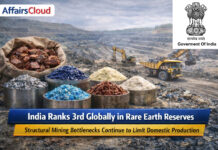
The Washington based multilateral lender, World Bank in its latest edition of the Global Economic Prospect (GEP) June 2020 analytical chapters reports states that India’s growth is contract by 3.2%(so growth is -3.2%) for FY20-21 .It was lower from 4.2% which forecasted in FY2019-20 at the end of March 2020.
The growth forecast is 9 percentage lower than the GEP forecasts from January 2020 when the growth was projected as 5.8%. But it also highlights that country’s growth is expected to be 3.1% for the FY 2021-22.
Acc. to the GEP report, the real impact of the Covid-19 and lockdown would be felt in the current fiscal (2020-21) beginning April, the central bank has been purchasing government bonds to ease the financial strains.
Impact in South Asian Region
Acc. to the bank projections, the Indian economy will have a spillover impact in South Asian regional activities despite having relatively more low-key trade linkages with the advanced economies than other EMDE (Emerging Market and Developing Economies) regions.
The growth rate projected in the region marked with high uncertainty has registered a contraction of -2.7% in 2020.
Why the Un-certainty?
Covid-19 infections are still rising in several economies in the South Asian region, despite the relatively low number of reported cases per capita. Across the region, the pandemic easing measures will severely curb consumption and services activity, while high uncertainty about the pandemic will restrict private investment.
What is EMDE?
Countries classified as emerging market and Developing economies are those with some, but not all, of the characteristics of a developed market (economy).
Indian Economy
i.The growth rate of the Indian economy in FY17 was 7% which dropped to 6.1% in FY18 and then to 4.2 % in FY20.
ii.The impact of the pandemic and lockdown is being felt in the current financial year (2020-2021 beginning April), with a negative growth rate of 3.2%.
Other Projected contractions Globally
i.The easing measures imposed in Pakistan and Afghanistan are expected to weigh majorly on private consumption contributing to contractions of -2.6% and -5.5% respectively, within labour-intensive export sectors like textiles to recover slowly after experiencing a sharp contraction.
ii.In Bangladesh projected to a substantial slack in this fiscal at a slow 1.6% due to the global exports plunge and payments fall in the sector.
iii.Nepal growth projection is to decline to 1.8% due to exports and a drop in tourism (China and India contribute to one-third of the tourism sector).
iv.Bhutan, Srilanka and Maldives to experience a sharp decline in tourism to weigh on their economic activity.
v.The US is expected to contract by 6.1% this year.
vi.The Euro area is projected to contract at 9.1%.
vii.Japan is expected to shrink at 6.1%.
viii.China is expected to show a four-decade slow of 1%.
Also, East Asia and the Pacific will grow by 0.5%. South Asia will contract by 2.7%, Sub-Saharan Africa contract by 2.8%, Middle East and North Africa contract by 4.2%, Europe and Central Asia contract by 4.7%, and Latin America and the Caribbean contract by 7.2%.
Note : According to Johns Hopkins University data, India is the fifth worst-hit nation by the Covid-19 pandemic after the US, Brazil, Russia and the UK.
For further details on the report please visithttps://openknowledge.worldbank.org/bitstream/handle/10986/33748/211553-Ch01.pdf
Global Economy to shrink by 5.2 % in 2020; World Bank
Acc. to the World Bank, the massive shock of the COVID-19 Pandemic and lockdown measures for its containment will lead to a contraction of the global economy by 5.2% in 2020.
Countries most reliant on global trade, tourism, external financing and commodity exports would be most affected.
Baseline forecast
Assuming that the pandemic will recede to allow the lifting of domestic easing measures in advanced economies and later in EMDEs.
Note : Advanced economies are projected to shrink 7 per cent.
i.Global forecast projected to rebound to 4.2% in 2021 with advanced economy growth at 3.9% and EMDE back at 4.6% (from 2.5% this year; the first contraction in 60 years).
ii.Downside Scenario states that the global economy could shrink by 8% (i.e 5% for EMDEs) which would see a slow and weak recovery at just above 1% growth in 2021.
Note: The vice president for equitable growth, finance and institutions at World Bank Group, and economist Ceyla Pazarbasioglu stated that the pandemic poses a major global challenge and its main objective is to set out to address the global health and economic emergency. In order to do so, the global community must unite and find ways to rebuild and recover.
EMDE to be vulnerable: World Bank; Covid-19 to push 60-million into poverty in 2020
The World Bank president David Malpass stated that an estimated 60 million people could be pushed into extreme poverty in 2020. Also, stating that this is likely to rise further with reopening of economies.
Policies for economic recovery; to limit damage and build stronger recovery
i.Debt transparency to invite new investment.
ii.Advanced Digital connectivity.
iii.Expansion of cash safety net for the poor.
iv.Faster litigation and solvency of bankruptcies
v.Resolve costly subsidies, monopolies and protected state-owned properties with slow development.
vi.G20 countries freezing loan repayments in low-income countries (starting May 1)
Other policies for long term growth (post-pandemic world):
i.Improving the environment for business.
ii.Improved governance and enhancing investments in education and public health.
Note: EDMEs that have restricted energy-intensive activities and not much monetary room to counteract the effects, the collapsed oil prices are not likely to reduce the adverse effects of the pandemic , but, there might be a short window of strategic recovery and support for economic activity with targeted stimulus measures.
About the World Bank Group
The World Bank is one of the largest sources of funding for developing countries. It partners with 5 private sector institutions; The IBRD (The International Bank for Reconstruction and Development), IDA(The International Development Association ), IFC( The International Finance Corporation), MIGA ( The Multilateral Investment Guarantee Agency) and ICSID( The International Centre for Settlement of Investment Disputes)
President– David Malpass




